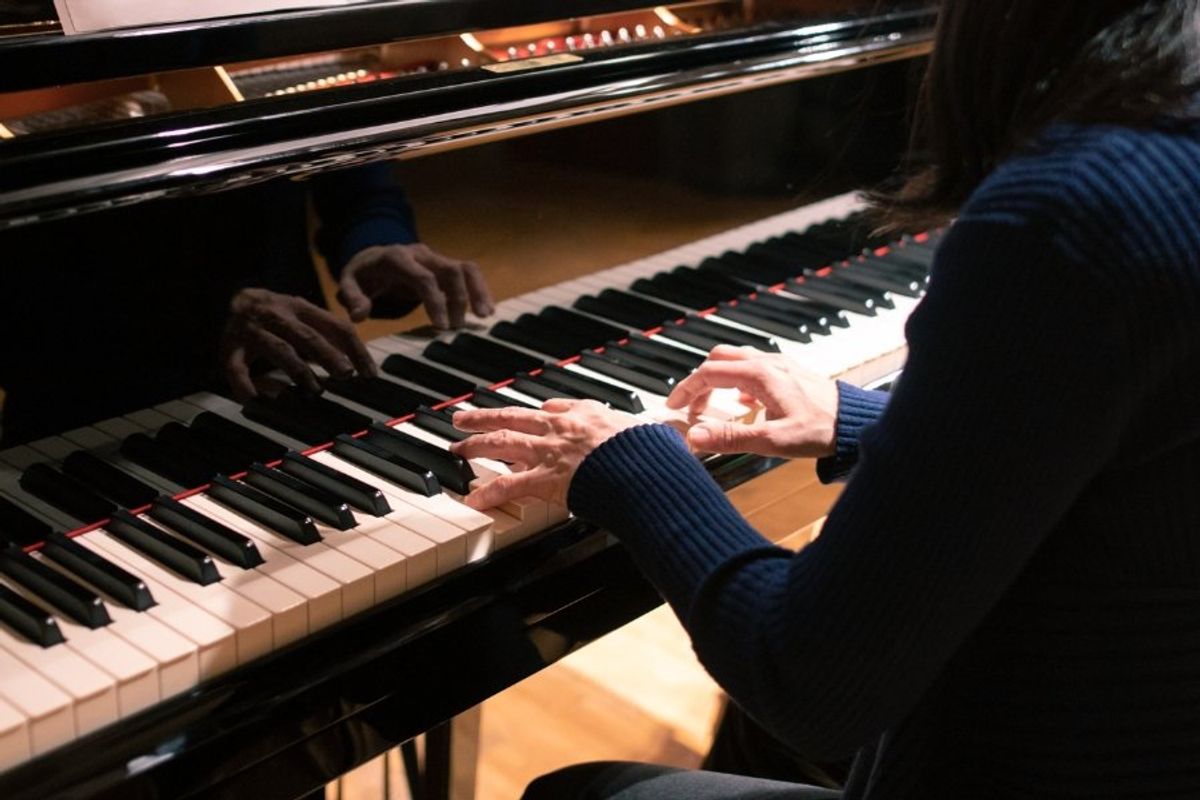A pianist on stage realized she'd prepared the wrong piece. Then she pulled off a miracle.
The encouraging conductor helped turn her "worst nightmare" scenario into a viral, magnificent feat.

Imagine showing up on stage to play a piano concerto and finding out you have to play a different one in two minutes.
You know that nightmare where you show up to the final day of class and there's a huge test and you panic as you realize you've missed the whole semester and haven't studied at all? Or how about the one where you have to give a big presentation at work and you show up totally unprepared—no notes, no visuals, no speech—and you have to wing it?
For musicians, the equivalent is showing up on stage to perform without preparation or rehearsal, which is exactly what happened to Portuguese pianist Maria João Pires when she was on stage in front of an audience of 2,000 people in Amsterdam in 1999. As the orchestra started to play, she quickly realized she was in trouble—she had prepared the wrong concerto. As the musicians played the two-and-a-half-minute intro to Mozart's Piano Concerto No.20, Pires sat at the piano in terror. She had not practiced that piece and she didn't even have the sheet music for it.
She had, however, played that concerto before, and in an inspiring feat of musicality, muscle memory, and sheer human will—along with some encouraging words from conductor Riccardo Chailly—Pires got herself centered and locked in, playing the correct concerto in its entirety, miraculously without missing a note.
The full story actually feels even more daunting for those of us who can't sit down and pound out a piano concerto at will. It turned out that Pires wasn't even the original pianist who was slated to play at this concert. She was asked the day before to be a replacement for the pianist who couldn't perform, so she didn't have a lot of time to prepare anyway. However, she'd misheard the number of the Mozart piece over the phone and thought it was a piece she had played only a couple of weeks before. If that had been the case, she would have been fine, even with the short notice. But having the wrong concerto in mind and then not even having the sheet music for the correct one was an extra pile-on from an already high-pressure situation.
The fact that it was a general rehearsal and not the official performance wasn't much consolation, since it was an open rehearsal with a full audience. A rehearsal audience is likely more forgiving than an audience that paid top dollar for a concert, but it's still mortifying to have thousands of people expecting you to perform something you have not prepared for.
Thankfully, Pires had performed the concerto multiple times, most recently about 10 or 11 months prior, so she wasn't clueless. But perfectly recalling something you did nearly a year ago at that level and under that amount of pressure is absolutely incredible.
The conductor who encouraged her later talked about how impressive it was. "The miracle is that she has such a memory that she could, within a minute, switch to a new concerto without making one mistake," said Chailly. However, Pires insists that her memory is not exceptional at all and that she is "very, very average" among musicians.
- YouTubewww.youtube.com
But it wasn't the only time this happened to Pires. "I must say, this happened to me another two times in my life. In total, three times," she told ClassicFM's Joanna Gosling. "I hope it never happens again."
Pires already gets nervous about performing, despite being a world famous concert pianist.
"I normally feel very stressed on stage," Pires said. "It's not the stage, it's not the public, it's the responsibility. I feel insecure. And that's why I'm not a stage person somehow. There is one side of me that feels okay—I feel okay with the people. But being on stage and being responsible for something can give me some panic."
As Gosling points out, if you were just listening to the performance, you'd never know there'd been an issue. But the camera on her face tells an entire story during the orchestral opening as we see her grappling with the crisis she'd found herself in. Watching the moment she decided she had no choice but to just go for it, whatever happened, is remarkable. A true testament to the power of repetition and the resilience of the human spirit, and a reminder that musicians truly are magicians in so many ways.





 Rihanna Nails GIF
Rihanna Nails GIF Dexters Laboratory What A Fine Day For Science GIF
Dexters Laboratory What A Fine Day For Science GIF The bread doesn't lie. Facebook/Jaralee Metcalf
The bread doesn't lie. Facebook/Jaralee Metcalf A Gen X text convo with Gen ZPhoto credit: Annie Reneau
A Gen X text convo with Gen ZPhoto credit: Annie Reneau Oh Yeah Mic Drop GIF by Taylor Bisciotti
Oh Yeah Mic Drop GIF by Taylor Bisciotti